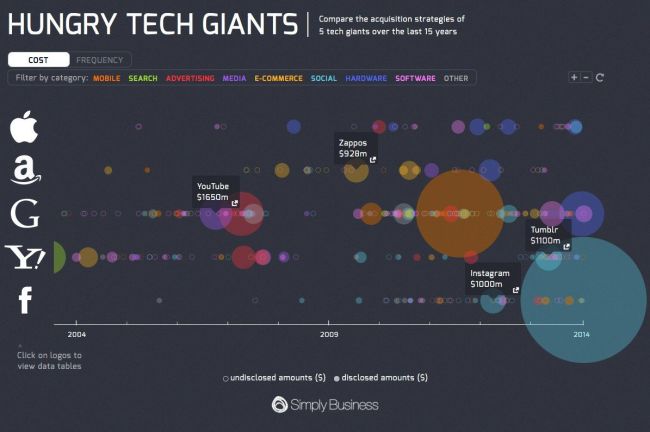
Hungry Tech Giants is a cool infographic from Simply Business that is both zoomable and interactive! To put them into context, the design visualizes 15 years of tech company acquisitions by Apple, Google, Yahoo, Amazon, And Facebook.
2013 was a busy year for tech acquisitions.
With competition in the tech space heating up, Apple, Amazon, Google, Yahoo, and Facebook collectively executed 65 acquisitions in 2013 alone.
Yahoo was the biggest acquirer of 2013, buying a total of 25 companies following the hiring of its new CEO, Marissa Meyer.
Although Meyer is best known for her acquisition of Tumblr, the majority of her deals have bought engineering talent in an effort to build Yahoo as a serious challenger to Google.
Apple also had their biggest ever year for acquisitions in 2013, with ten purchases in total.
To see all of the acquisitions in detail, please visit our interactive microsite.
Each acquisition is appropriately placed on the timeline, and shown as a circle sized to match the total acquisition price. Solid circles shown known prices, and open circles are not sized because the acquisition amount was never released publicly. The circles are also color-coded to represent the different categories.
The interactivity allows you to select which categories to show, and when you hover over any particular acquisition, the acquired company name is shown with a link to the press release or news story announcing the acquisition.
The zooming controls allow you to adjust the date range shown, which helps identify many of the overlapping circles. Clicking on the company logos on the left also brings up the data table which shows all of the known values, dates and includes the links to the press releases. A very good way to establish credibility and make your data sources transparent.
The overall design is meant to be very detailed and allow the audience to dig in and explore the data. At the macro level, the infographic clearly puts Facebook’s $19B acquisition of WhatsApp into context as the largest tech acquisition of all time!
Found on TechCrunch and Cult of Mac!









 Randy
Randy









